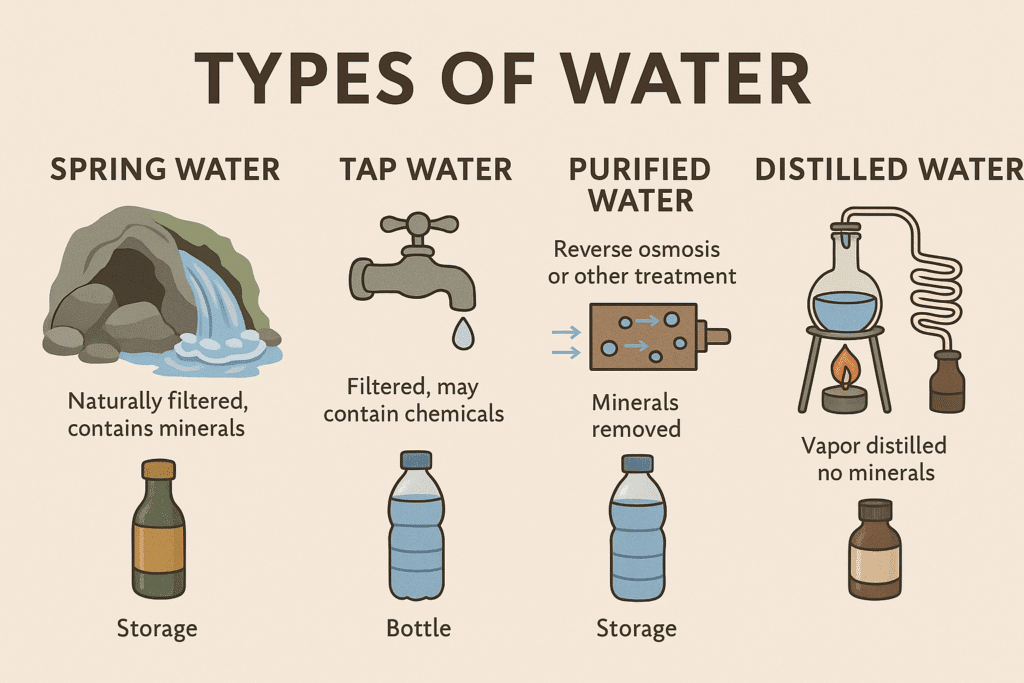(What We’re Actually Supposed to Drink — and What We’ve Screwed Up)
Everyone’s obsessed with clean eating, seed oils, organ meats — great. But no one’s talking about water, and that’s a problem. Because if you’re eating perfectly and still feel off — foggy, crampy, tired, bloated — your water might be the real issue.
We’ve gone from drinking mineral-rich spring water flowing over rocks to sucking down dead, filtered tap water stored in plastic. That’s a hard downgrade, biologically speaking. Let’s get into it — what real hydration actually looks like, what you’re probably missing, and how to fix it without overcomplicating your life.

Not All Water Is the Same (Stop Thinking It Is)
Here’s the breakdown:
- Tap water = filtered chemical soup. You might get chlorine, fluoride, PFAS, pharma runoff, and maybe a side of microplastics. Just because it won’t kill you doesn’t mean it’s helping you.
- Purified water sounds clean, but it’s usually RO or distilled — meaning it’s been stripped of everything, including minerals your body actually needs.
- Spring water (the real kind, from underground aquifers) has minerals like magnesium, calcium, potassium — the stuff your nervous system, muscles, and brain run on.
- Distilled water is fine short-term, like for fasting or detox, but long-term? It’ll pull minerals from your body unless you re-mineralize it.
What Did Humans Actually Drink?
We weren’t designed to drink from a Brita. Ancestrally, humans drank from natural springs, rain catchments, or glacial melt — all of which were:
- Naturally filtered through rock
- Rich in trace minerals
- Structured and alive (yes, water has a structure — more on that in a sec)
- Stored in ceramic, wood, or stone — not plastic
Compare that to what’s in your average grocery store bottle. It’s filtered to death, sits in hot plastic, and is totally dead. You’re drinking water — but not hydrating.
Why You Still Feel Dehydrated
If you’re drinking a ton of water and still feeling dry, bloated, or crampy — here’s why: you’re missing minerals. Water without minerals is like fuel without spark. Your body needs electrolytes to actually absorb and use it.
- Sodium: Balances fluids, keeps you sharp
- Potassium: Crucial for nerve and heart function
- Magnesium: The anti-stress mineral
- Calcium: For bone, nerve, and muscle function
If you’re drinking reverse osmosis or distilled water without adding minerals back in, you’re flushing your system without actually fueling it.
Structured Water, Grounding, and the Woo That’s Actually Real
Structured water — the kind found in natural springs — is said to be more bioavailable. Some call it EZ water (exclusion zone), and while the science is still catching up, the energy of water matters.
Walking barefoot on the earth (aka grounding) and sunlight both affect how water behaves inside your cells. It’s wild — but real. You’re not just drinking water for hydration — you’re feeding your cellular battery.
Glass vs. Plastic (Yes, It Matters)
If you’re still buying bottled water in plastic jugs and storing it on your kitchen counter under the sun… yikes. Heat + plastic = endocrine disruptors. Even BPA-free doesn’t mean safe.
Best options:
- Glass (top tier)
- Stainless steel
- Ceramic or clay (old school, still works)
Store your water like you store your food — somewhere cool, dark, and non-toxic.
Real Talk: What You Should Be Drinking
If you want to hydrate like a human, not a lab rat:
- Filter your tap water — Use a gravity filter like Berkey or Clearly Filtered.
- Add minerals back — Celtic salt, Redmond’s, or trace mineral drops.
- Store in glass — Always.
- Drink early and often — Start your day with minerals + water before food or coffee.
- Bonus points: Get real spring water if you can (findaspring.com). It’s the gold standard.
Final Thought
Hydration isn’t just about “drinking enough water.” It’s about drinking the right kind of water, the way humans have for thousands of years — mineral-rich, stored safely, not chemically processed and stripped bare.
If your energy, digestion, mood, or sleep are off — look at your water. This is foundational stuff.
Sources:
Gropper, Sareen S., and Jack L. Smith. Advanced Nutrition and Human Metabolism. 7th ed., Cengage Learning, 2021.
https://www.cengage.com/c/advanced-nutrition-and-human-metabolism-7e-gropper
“Water Sanitation and Health.” World Health Organization,
https://www.who.int/water_sanitation_health/dwq/nutrientsindw.pdf
Seneff, Stephanie. “How Modern Water and Lack of Minerals Fuel Chronic Disease.” MIT Research,
https://people.csail.mit.edu/seneff
“Hydration, Electrolytes and Human Performance.” National Institutes of Health,
https://www.ncbi.nlm.nih.gov/pmc/articles/PMC2907136/

Leave a Reply